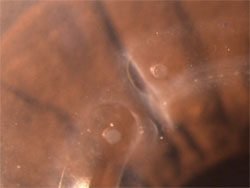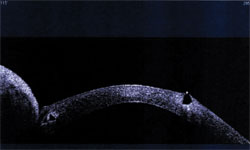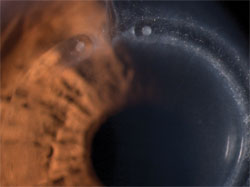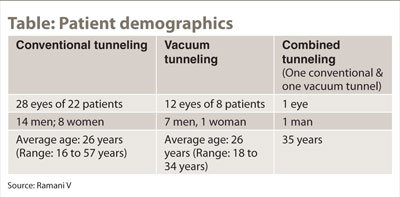Vacuum system offers alternative to mechanical dissection for corneal ring implantation
A new vacuum tunneling system uses less pressure and may have a shorter learning curve for surgeons.
In Asia, mechanical dissection for corneal ring implantation is still widely used in keratoconic cases due to the cost to patients if a femtosecond laser is used.
Manual tunneling
While manual tunneling is less expensive to perform, the procedure can be problematic in patients who have previously undergone corneal collagen cross-linking. Further, it can be challenging to insert the rings, and the depth of tunneling may also vary, depending on the cooperation of the patient.
The key components used in a manual procedure are a diamond knife and a device to create the corneal tunnel, but the original devices used to create the tunnel were large and difficult to handle. In addition, there were complications associated with incorrect tunneling technique, including extrusion of the ring (Figure 1a), superficial placement of the ring resulting in epithelial erosion and ring exposure (Figure 1b), as well as the development of corneal exudates along the ring (Figure 1c), which can be confused with an infection.
Vacuum tunneling
An alternative to the manual approach is to use a vacuum device to stabilize the globe during creation of the corneal tunnel. The new Keraring vacuum tunneling system (Mediphacos) is a simple device that consists of a vacuum ring that fits most eyes (in Malaysia, for example, we see many Chinese patients with very small eyes) and slimmer devices to create the tunnel. The Keraring vacuum tunneling system is easier to use and may be associated with a shorter learning curve for the surgeon than the conventional manual tunneling system. The procedure is performed under local anesthetic. The patient is not uncomfortable, the pupil does not get dilated, and usually there is not much pressure with this system. It is important not to over-pressurize the globe during this step because in rare cases this can lead to endothelial perforation.



Although there are other vacuum tunneling systems on the market, these systems are more complicated to use and require higher levels of vacuum pressure compared with the Mediphacos device.
Comparing clinical outcomes
Given the improved ease of use offered by the vacuum tunneling system, we sought to evaluate if there was a clinical difference in outcomes between this technique and the conventional manual approach. Our study included 41 eyes scheduled for implantation of the Keraring. Twenty-eight eyes of 22 patients were included in the conventional group, and 12 eyes of eight patients were included in the vacuum tunneling group. In addition, we included one patient who underwent a combined procedure using the conventional and vacuum techniques (Table).

All patients were followed for 3 months postoperatively in order to measure the maximum flattening effect, as well as to determine if further treatment, such as corneal cross-linking, was necessary. Complications included ring extrusions that necessitated the removal and reinsertion of the rings in four eyes. In one eye, a corneal ring with a different diameter was used.
The initial results indicated a moderate but consistent difference between the conventional and vacuum groups, which trended in favor of the vacuum technique. The vacuum tunneling showed quicker visual recovery, better visual acuity and a better corneal shape.
In summary, both conventional and vacuum tunneling are effective mechanical dissection procedures for corneal ring implantation, but vacuum tunneling is easier to use and may have the added advantage of a shorter learning curve for the surgeon.
For more information:
Vera Ramani, MD, can be reached at The Tun Hussein Onn National Eye Hospital, Lorong Utara B, 46200, Petaling Jaya, Selangor Darul Ehsan, Malaysia; +603-7718-1488; email: vramani@mobileemail.vodafone.com.my, medical.coordinator@thoneh.com.
Disclosure: Ramani has no relevant financial disclosures.
